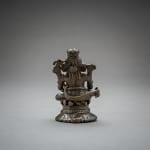Bronze Figure of Ganesh, 1600 CE - 1700 CE
Bronze
7.1 x 4.6 cm
2 3/4 x 1 3/4 in
2 3/4 x 1 3/4 in
OF.023
Further images
Ganesh is one of the most instantly recognisable divinities of the Hindu pantheon, in possessing a well-nourished human body, multiple arms and the head of an elephant. He is celebrated...
Ganesh is one of the most instantly recognisable divinities of the Hindu pantheon, in possessing a well-nourished human body, multiple arms and the head of an elephant. He is celebrated as the Lord of Obstacles (and their removal) and of Beginnings. He is also the patron of arts/sciences and letters, and the deva (deity) of intellect and wisdom. His iconographic symbolism varies, although he is most often seated. He often holds a piece of his own broken tusk in one hand, having cut it off to make a pen to write down sacred Hindu knowledge. The trunk snaking to the left indicates his sniffing at a sweetmeat held in the lower left hand, which is a very traditional rendering of the figure. He also holds an axe and a goad; in the current case one hand (the lower right) is missing. This hand would have held wither his broken tusk, or would have been extended in abhaya mudra as a gesture of protection towards the viewer. The animal behind and to his right is a rat/mouse, which is his mount in the Gajanana holy books. The significance of this is debatable but may relate to literally rising above earthly desires and temptations.
The ornate pedestal base, which seems to be modelled on a lotus blossom, indicates that this is probably a southern Indian form. The well-smoothed surface implies a certain age, probably the mid 18th century. This is an attractive and appealing piece of Indian bronzework.
The ornate pedestal base, which seems to be modelled on a lotus blossom, indicates that this is probably a southern Indian form. The well-smoothed surface implies a certain age, probably the mid 18th century. This is an attractive and appealing piece of Indian bronzework.







